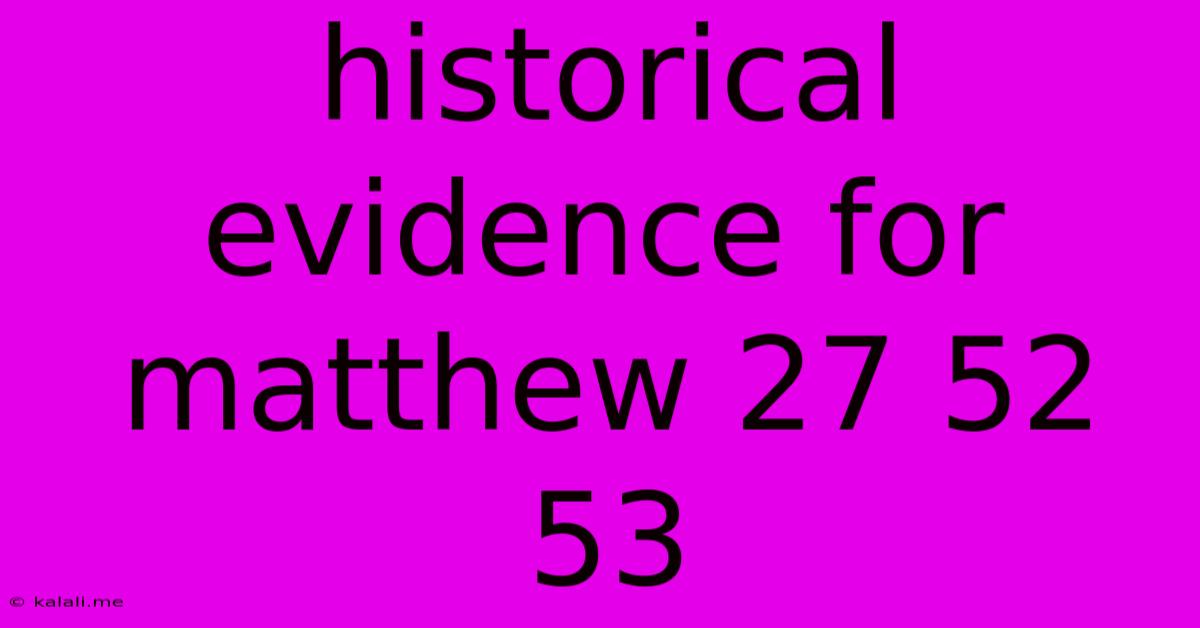Historical Evidence For Matthew 27 52 53
Kalali
May 25, 2025 · 3 min read

Table of Contents
Historical Evidence for Matthew 27:52-53: A Critical Examination
Matthew 27:52-53 describes a significant earthquake and the opening of tombs in Jerusalem following Jesus' crucifixion. This passage has sparked considerable debate among scholars, with questions raised about its historical accuracy and potential symbolic interpretation. This article will delve into the historical evidence, or lack thereof, for these events, examining both supporting arguments and counter-arguments. We will explore the historical context of the period, considering archaeological findings and contemporaneous writings to assess the plausibility of the account.
The passage itself reads: "And the graves were opened, and many bodies of the saints who had fallen asleep were raised; and coming out of the graves after His resurrection, they went into the holy city and appeared to many." (Matthew 27:52-53, NKJV). The account suggests a supernatural event accompanying the crucifixion, emphasizing the momentous nature of Jesus' death. However, independent verification of this event is lacking.
The Absence of Corroborating Evidence
A major challenge in verifying the Matthew 27:52-53 account is the absence of corroborating evidence from other historical sources. Josephus, a first-century Jewish historian who provides detailed accounts of the Roman occupation of Judea and the tumultuous period surrounding Jesus' life, makes no mention of such an earthquake or the resurrection of the saints. Similarly, other contemporary writings from the period are silent on this event. This lack of corroboration raises questions about the historicity of the narrative.
Some argue that the omission is not surprising, given the potentially controversial nature of the claim. However, the magnitude of the event described—an earthquake accompanied by the resurrection of numerous individuals—suggests that it would have been difficult to overlook or suppress entirely in contemporary historical accounts.
The Nature of the Gospel Accounts: History or Theology?
It's crucial to consider the genre of the Gospels. While they contain historical elements, they are also theological narratives aiming to convey the significance of Jesus' life, death, and resurrection. Some scholars argue that the earthquake and resurrection of the saints are symbolic representations of the transformative power of Jesus' death, rather than literal historical accounts. The opening of the tombs could represent the shattering of death's power, and the resurrection of the saints could symbolize the spiritual awakening brought about by Jesus' sacrifice.
This interpretation aligns with other passages in the Gospels that use symbolic language to convey deeper theological truths. It allows for the narrative’s powerful message to be understood without requiring literal interpretation of every detail.
Archaeological Evidence and Earthquakes in Judea
While there is no archaeological evidence directly supporting the specific events described in Matthew 27:52-53, historical records do document earthquakes in Judea during the Roman period. The occurrence of earthquakes in the region is well-established, lending a degree of plausibility to the earthquake element of the narrative, even if not to the specific details. However, the absence of evidence for mass exhumations or appearances of resurrected individuals remains a significant hurdle for a purely historical interpretation.
Conclusion: A Matter of Interpretation
The historical evidence for Matthew 27:52-53 is inconclusive. The absence of corroboration from other historical sources, coupled with the theological context of the Gospels, leaves room for both a literal and a symbolic interpretation of the passage. While the occurrence of earthquakes in Judea is documented, there is no independent verification for the resurrection of the saints. Ultimately, the interpretation rests on individual perspectives and approaches to biblical interpretation, considering both the historical and theological dimensions of the text. Further research and critical analysis of the historical and theological contexts are needed for a more comprehensive understanding of this debated passage.
Latest Posts
Latest Posts
-
Toon Boom Harmony Cant Select Control Point Transorm
May 25, 2025
-
Java Does A Int Return Need To Be Boolean
May 25, 2025
-
How To Spell On In Spanish
May 25, 2025
-
How To Remove A Screw With A Broken Head
May 25, 2025
-
How To Wash Rust Stains From Clothes
May 25, 2025
Related Post
Thank you for visiting our website which covers about Historical Evidence For Matthew 27 52 53 . We hope the information provided has been useful to you. Feel free to contact us if you have any questions or need further assistance. See you next time and don't miss to bookmark.